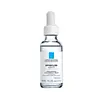What's inside
What's inside
 Key Ingredients
Key Ingredients

 Benefits
Benefits

 Concerns
Concerns

 Ingredients Side-by-side
Ingredients Side-by-side

Water
Skin ConditioningAlcohol Denat.
AntimicrobialHydroxyethylpiperazine Ethane Sulfonic Acid
BufferingGlycolic Acid
BufferingDiisopropyl Adipate
EmollientPropylene Glycol
HumectantPentylene Glycol
Skin ConditioningCitric Acid
BufferingPPG-26-Buteth-26
Skin ConditioningPEG-30 Glyceryl Cocoate
EmulsifyingPEG-40 Hydrogenated Castor Oil
EmulsifyingSodium Hydroxide
BufferingP-Anisic Acid
MaskingHydrolyzed Hyaluronic Acid
HumectantCapryloyl Salicylic Acid
ExfoliatingTetrasodium EDTA
Polyquaternium-10
Water, Alcohol Denat., Hydroxyethylpiperazine Ethane Sulfonic Acid, Glycolic Acid, Diisopropyl Adipate, Propylene Glycol, Pentylene Glycol, Citric Acid, PPG-26-Buteth-26, PEG-30 Glyceryl Cocoate, PEG-40 Hydrogenated Castor Oil, Sodium Hydroxide, P-Anisic Acid, Hydrolyzed Hyaluronic Acid, Capryloyl Salicylic Acid, Tetrasodium EDTA, Polyquaternium-10
Water
Skin ConditioningPropanediol
SolventGlycerin
HumectantSqualane
EmollientGlycereth-26
HumectantGlyceryl Polyacrylate
Mica
Cosmetic ColorantCetearyl Alcohol
EmollientBakuchiol
AntimicrobialPolyacrylate Crosspolymer-6
Emulsion StabilisingDimethicone
EmollientPolyglyceryl-10 Laurate
Skin ConditioningAminomethyl Propanol
BufferingHydrolyzed Jojoba Esters
Skin ConditioningPhenoxyethanol
PreservativeHydroxyacetophenone
AntioxidantParfum
MaskingCeteareth-20
CleansingGlycolic Acid
BufferingLactic Acid
BufferingLeontopodium Alpinum Callus Culture Extract
AntioxidantCaesalpinia Spinosa Fruit Extract
Skin ProtectingCellulose Gum
Emulsion StabilisingHibiscus Sabdariffa Flower Extract
Skin ConditioningKappaphycus Alvarezii Extract
Skin ConditioningSilica
AbrasiveGlycyrrhiza Glabra Root Extract
BleachingCitrus Limon Fruit Extract
MaskingSaccharum Officinarum Extract
MoisturisingChamomilla Recutita Flower Extract
MaskingSantalum Album Extract
CleansingTrisodium Ethylenediamine Disuccinate
Leuconostoc/Radish Root Ferment Filtrate
AntimicrobialXanthan Gum
EmulsifyingEthylhexylglycerin
Skin ConditioningCitric Acid
BufferingLimonene
PerfumingLinalool
PerfumingCitral
PerfumingCI 77891
Cosmetic ColorantCI 60730
Cosmetic ColorantCI 14700
Cosmetic ColorantWater, Propanediol, Glycerin, Squalane, Glycereth-26, Glyceryl Polyacrylate, Mica, Cetearyl Alcohol, Bakuchiol, Polyacrylate Crosspolymer-6, Dimethicone, Polyglyceryl-10 Laurate, Aminomethyl Propanol, Hydrolyzed Jojoba Esters, Phenoxyethanol, Hydroxyacetophenone, Parfum, Ceteareth-20, Glycolic Acid, Lactic Acid, Leontopodium Alpinum Callus Culture Extract, Caesalpinia Spinosa Fruit Extract, Cellulose Gum, Hibiscus Sabdariffa Flower Extract, Kappaphycus Alvarezii Extract, Silica, Glycyrrhiza Glabra Root Extract, Citrus Limon Fruit Extract, Saccharum Officinarum Extract, Chamomilla Recutita Flower Extract, Santalum Album Extract, Trisodium Ethylenediamine Disuccinate, Leuconostoc/Radish Root Ferment Filtrate, Xanthan Gum, Ethylhexylglycerin, Citric Acid, Limonene, Linalool, Citral, CI 77891, CI 60730, CI 14700
Ingredients Explained
These ingredients are found in both products.
Ingredients higher up in an ingredient list are typically present in a larger amount.
Citric Acid is an alpha hydroxy acid (AHA) naturally found in citrus fruits like oranges, lemons, and limes.
Like other AHAs, citric acid can exfoliate skin by breaking down the bonds that hold dead skin cells together. This helps reveal smoother and brighter skin underneath.
However, this exfoliating effect only happens at high concentrations (20%) which can be hard to find in cosmetic products.
Due to this, citric acid is usually included in small amounts as a pH adjuster. This helps keep products slightly more acidic and compatible with skin's natural pH.
In skincare formulas, citric acid can:
While it can provide some skin benefits, research shows lactic acid and glycolic acid are generally more effective and less irritating exfoliants.
Most citric acid used in skincare today is made by fermenting sugars (usually from molasses). This synthetic version is identical to the natural citrus form but easier to stabilize and use in formulations.
Read more about some other popular AHA's here:
Learn more about Citric AcidGlycolic Acid is arguably the most famous alpha hydroxy acid (AHA) with tons of research backing its benefits.
It is found naturally in sugar cane but the form used in skincare is usually synthetic for purity and stability.
Glycolic acid removes the top layer of dead skin cells to allow newer and fresher ones to emerge.
AHAs work by breaking down the structural “glue” that holds old skin cells in place. When that buildup is gone, your skin can renew itself more efficiently.
Research also shows glycolic acid stimulates collagen production, helping to firm and thicken the skin over time. This is one of its biggest advantages over other AHAs.
Overall, glycolic acid helps with:
Fun fact: Glycolic acid boosts skin hydration by helping it produce molecules that increase hyaluronic acid naturally.
To work best, glycolic acid products should have a pH between 3-4 (that’s where exfoliation is most effective but still gentle on skin).
The pH and concentration of a product are key to its effectiveness:
It is normal to feel a slight stinging sensation when using glycolic acid. This usually fades as your skin adjusts.
Because glycolic acid has the smallest molecular size in the AHA family, it can penetrate deeper, which enhances its effectiveness but also makes it more likely to irritate sensitive skin.
If your skin is very sensitive or prone to rosacea, glycolic acid may be too strong; in that case, try milder options like lactic acid or a PHA instead.
Recent studies suggest glycolic acid might even help protect against UV damage. But don’t skip sunscreen! Freshly exfoliated skin is more sensitive to the sun.
Glycolic acid is a skincare superstar. It smooths, brightens, hydrates, and firms the skin. Unless you’re highly sensitive, it’s well worth adding to your routine.
Read more about some other popular AHA's here:
Learn more about Glycolic AcidWater. It's the most common cosmetic ingredient of all. You'll usually see it at the top of ingredient lists, meaning that it makes up the largest part of the product.
So why is it so popular? Water most often acts as a solvent - this means that it helps dissolve other ingredients into the formulation.
You'll also recognize water as that liquid we all need to stay alive. If you see this, drink a glass of water. Stay hydrated!
Learn more about Water